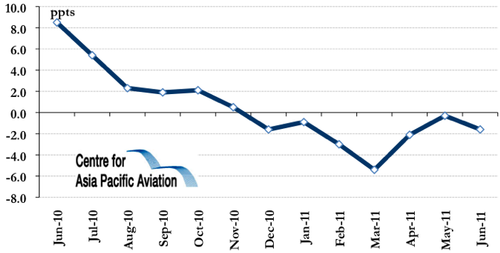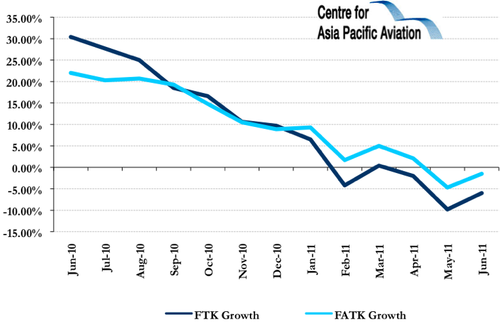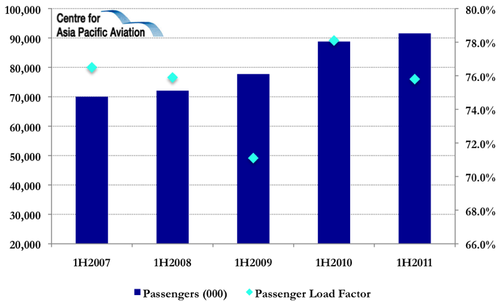Outlook ‘reasonably’ positive for Asia Pacific airlines in 2H2011: AAPA
Asia Pacific airlines reported continued expansion in international passenger demand in Jun-2011, although international air freight markets softened further during the month, according to data released by the Association of Asia Pacific Airlines (AAPA). The outlook for the second half of 2011 remains "reasonably positive" AAPA noted, with premium demand remaining strong on many business routes and Japan traffic starting to recovery. AAPA however cautioned over the uncertainty related to the strength of the global economic recovery and oil price volatility.
International scheduled services of Asia Pacific Airlines: AAPA
15.5 million international passenger handled by Asia Pac airlines in Jun-2011
During Jun-2011, airlines based in the Asia Pacific region carried a total of 15.5 million international passengers, a 4.4% year-on-year increase. Passenger numbers have increased in all but one (Feb-2011) month of 2011 and in every month of 2010.
AAPA passenger numbers growth and passenger load factor: Jun-2010 to Jun-2011
International passenger traffic (RPKs) increased by 4.5%, failing to keep pace with a 6.7% capacity (ASKs) increase, resulting in a 1.6 ppt decline in the average international passenger load factor to 77.5%.
International opacity growth at Asia Pacific airlines has exceeded traffic growth for the past seven months, and for every month of 2011. As a result, load factor have also declined for the past seven months (Dec-2010 through Jun-2011) after 16 consecutive months of year-on-year load factor growth (Aug-2009 to Nov-2010).
AAPA RPK growth and ASK growth: Jun-2010 to Jun-2011
AAPA PLF growth: Jun-2010 to Jun-2011
This scenario is noted limited to Asia Pacific airlines. IATA earlier this month noted that load factors are now down on their 2010 peaks, and with demand-supply conditions weakening, prospects for significant further yield increases are waning. Meanwhile, yield-boosting fuel surcharges are being held rather than increased (and in some cases reduced) while increasing capacity may reduce scope for underlying fare rises if passenger load factors fall as a result. IATA's own forecast is for a 3% increase in passenger yields over the course of 2011 - half the rise seen in 2010.
International air freight markets softened further
International air cargo demand (FTKs) declined 6.0% year-on-year, a reflection of the strong recovery in 2010, and some recent moderation in demand for Asian exports. Offered freight capacity declined by 1.5%, leading to a 3.1 ppt decline in the average international freight load factor to 67.3%.
AAPA FTK growth and FATK growth: Jun-2010 to Jun-2011
92 million international passengers for Asia Pacific airlines in 1H2011
During 1H2011, Asia Pacific airlines carried 92 million international passengers, a 3.1% year-on-year increase. However, capacity growth of 6.8% outpaced the 3.7% increase in traffic, resulting in a 2.3 ppt load factor decline to 75.8%. At the same time, international air cargo demand during the first half of the year was relatively soft, declining by 3.2% compared to last year's post-recession restocking surge.
AAPA passenger numbers and passenger load factor: 1H2007 to 1H2011
Outlook for second half remains 'reasonably positive' despite challenges
Looking forward, Mr Herdman continued noted that despite the demand-capacity inbalance, the outlook for the second half of the year "still remains reasonably positive, given the normal seasonal pattern of stronger demand for both passengers and cargo".
Amongst positive indicators is the emerging recovery in Japan related traffic, robust consumer confidence across the Asia Pacific region and strong demand for premium class seats on many popular business routes. AAPA however noted "some uncertainties remain about the strength of the global economic recovery, and unresolved macro-economic imbalances, evident in ongoing currency and oil price volatility." "Overall, the combination of lower utilisation, and other cost pressures including very high oil prices, places further downward pressure on already thin airline operating margins," Mr Herdman added.





